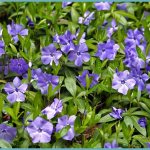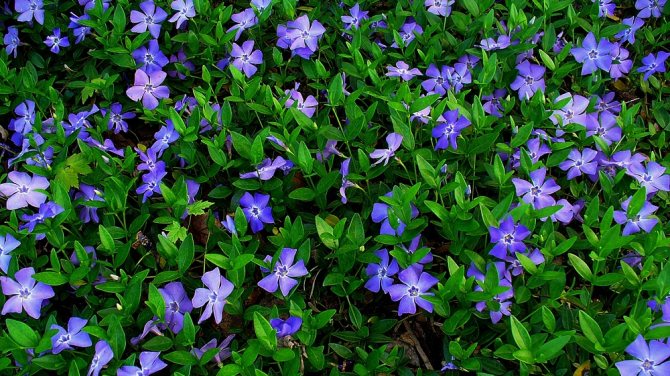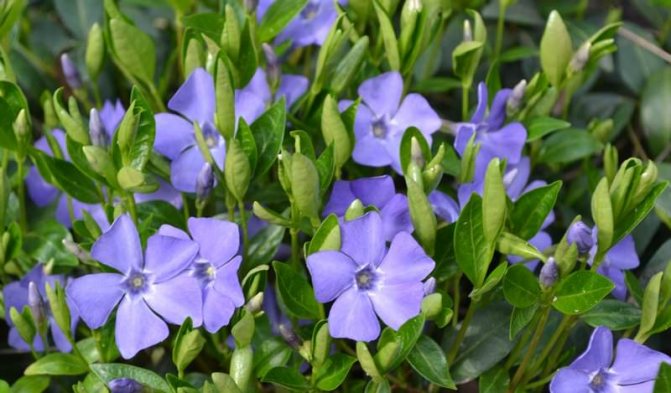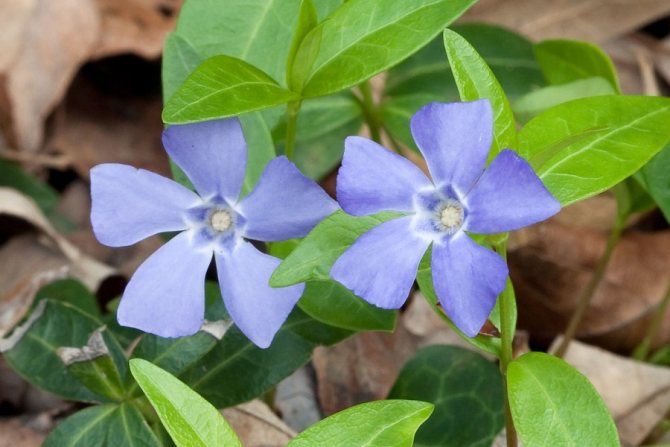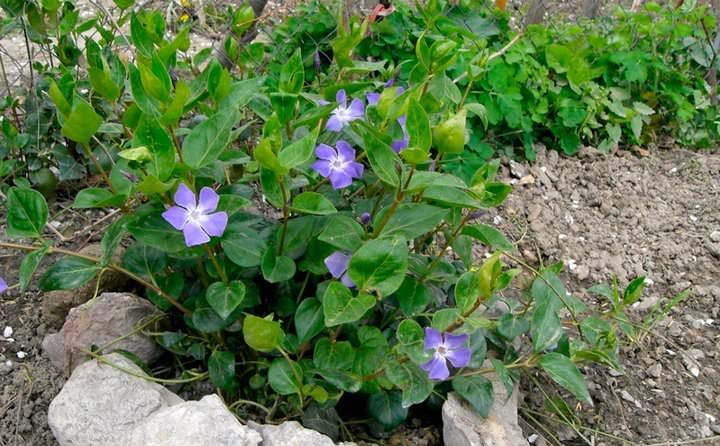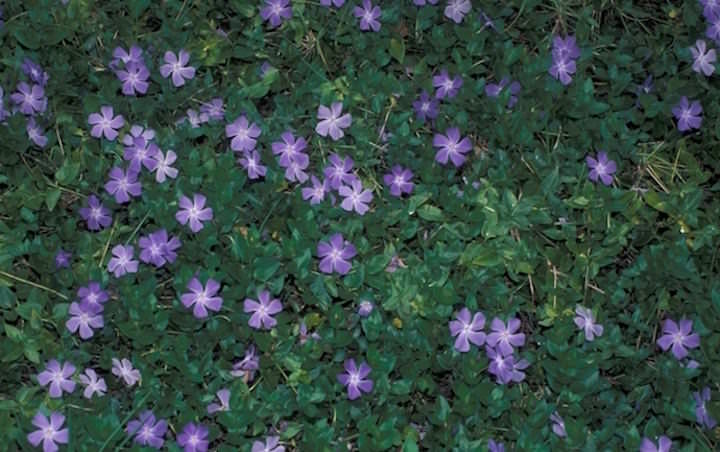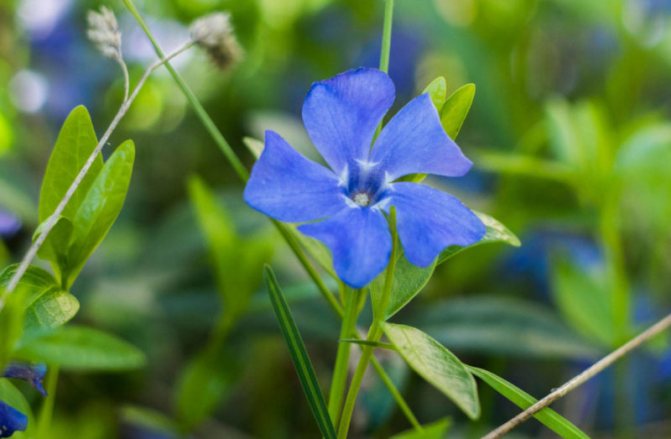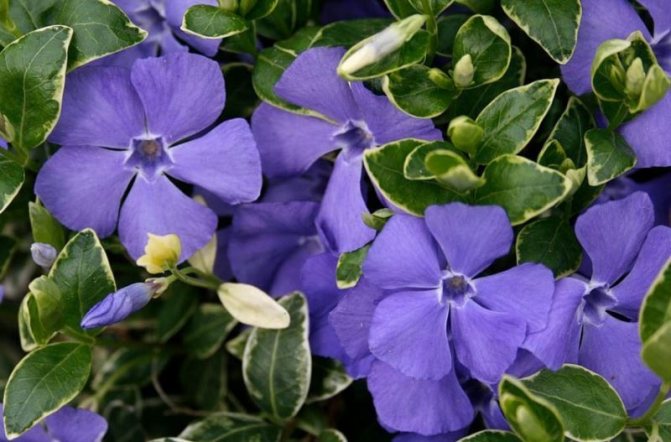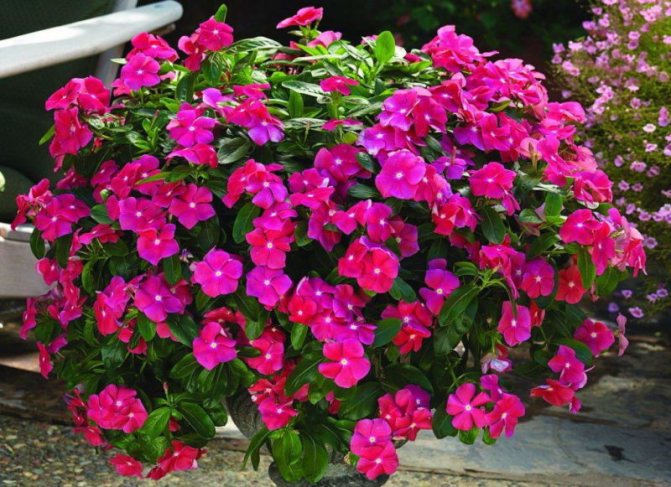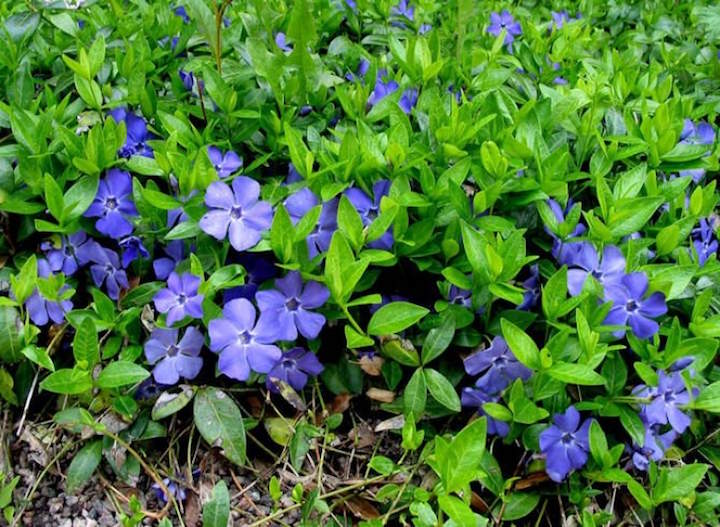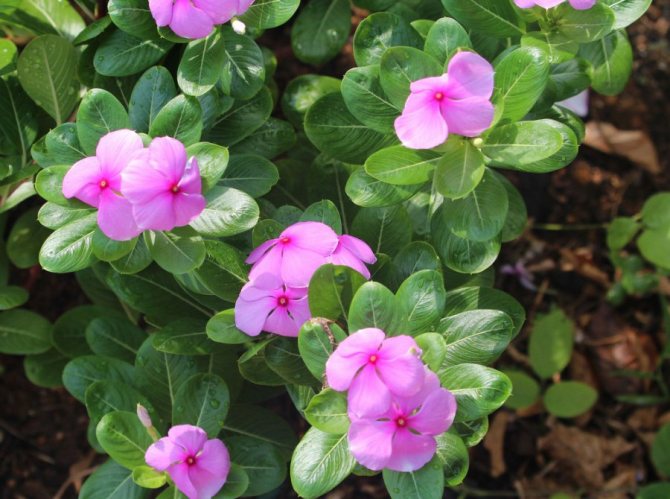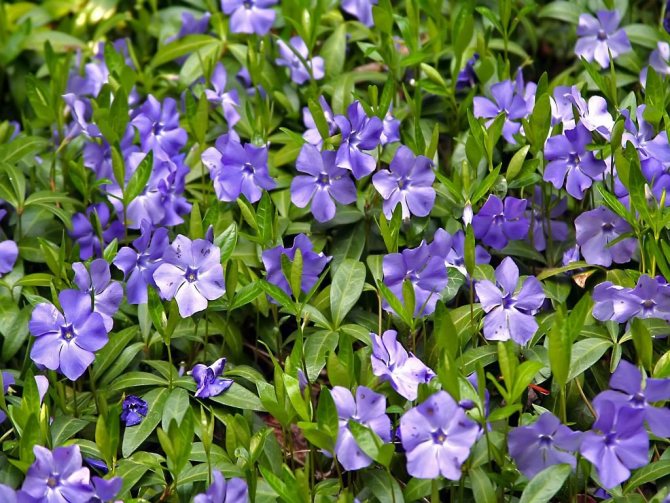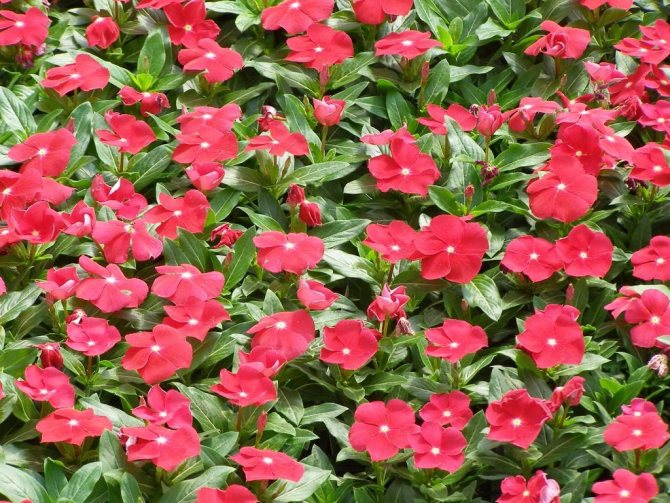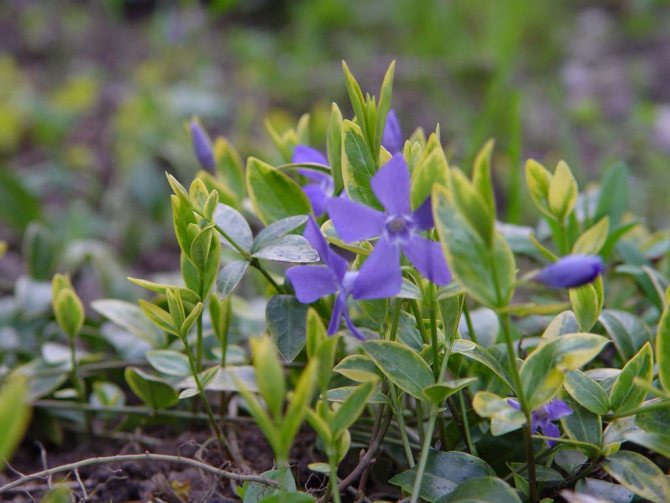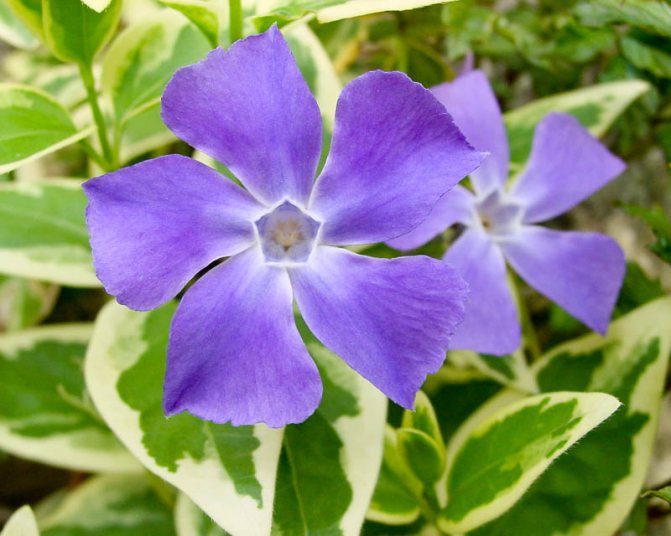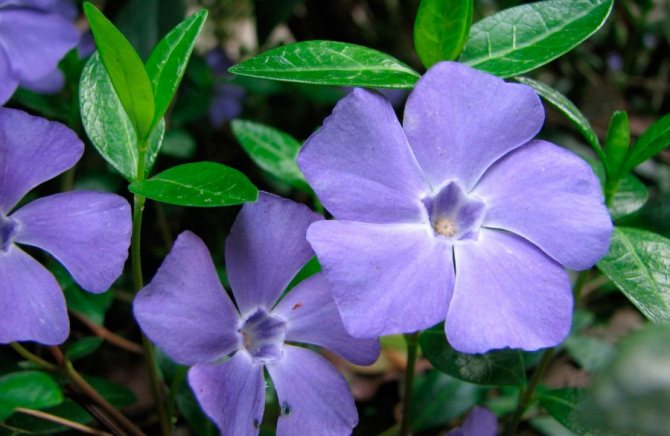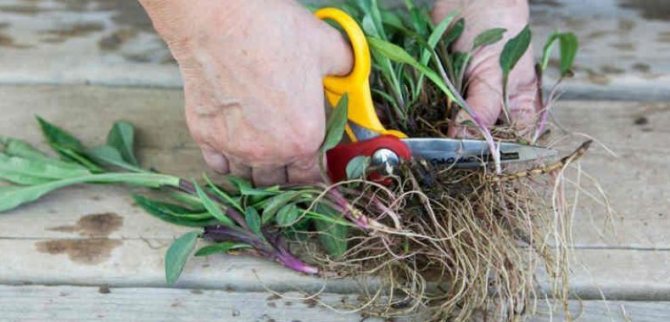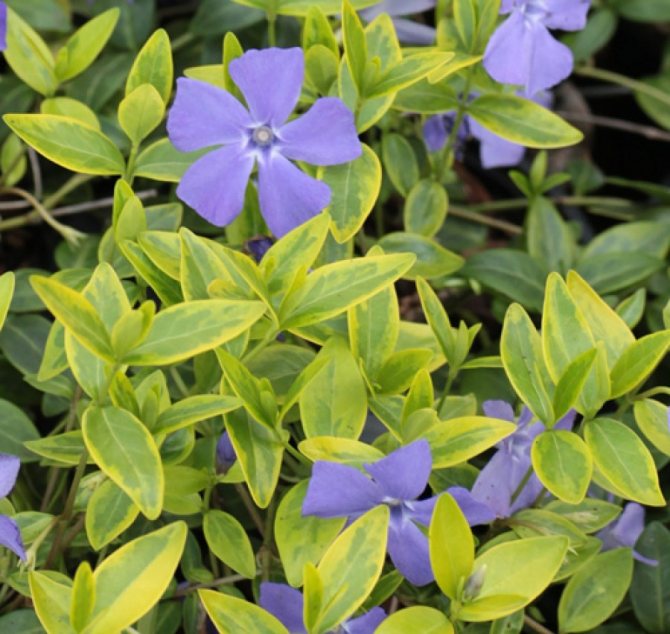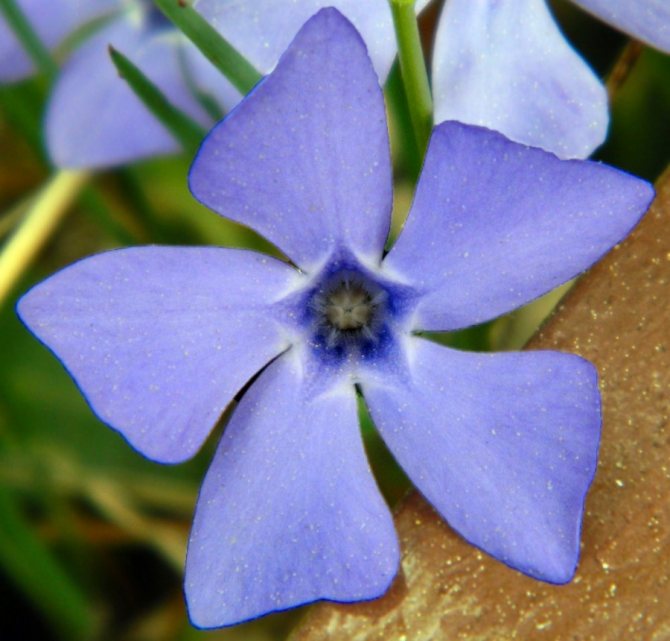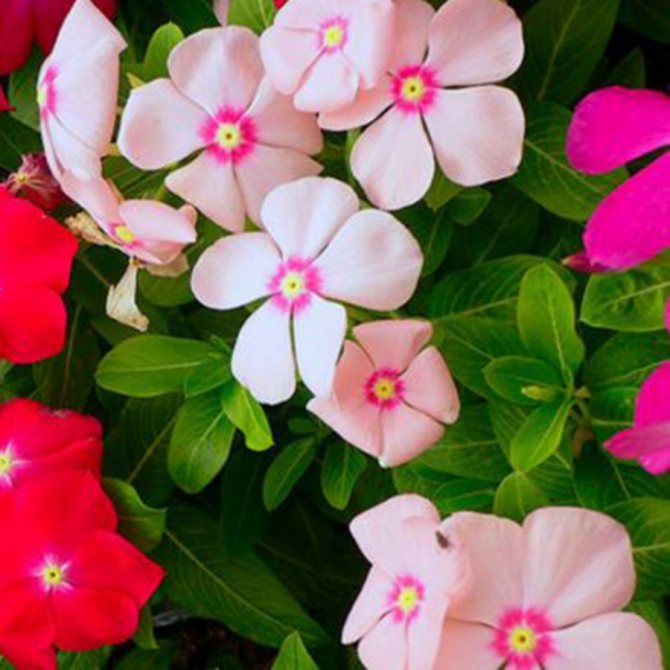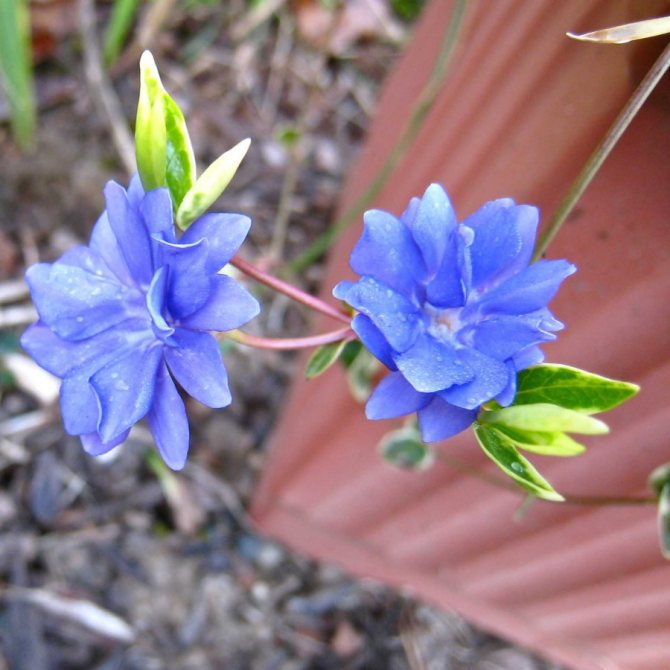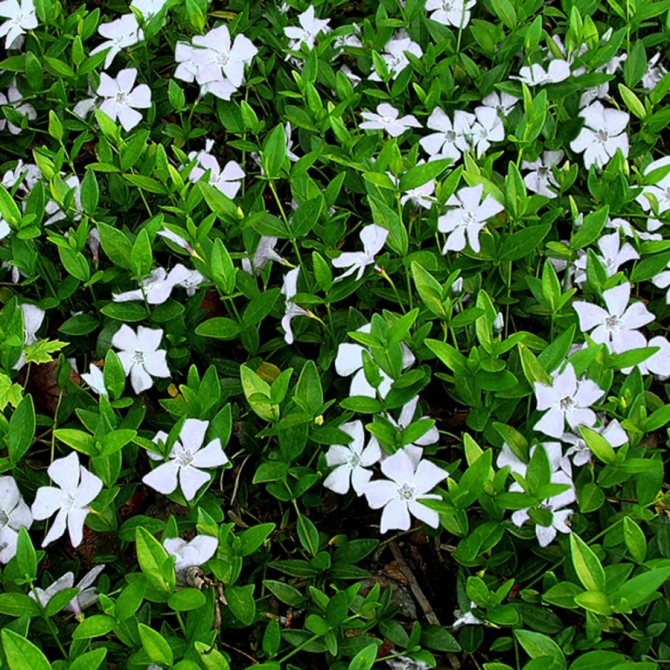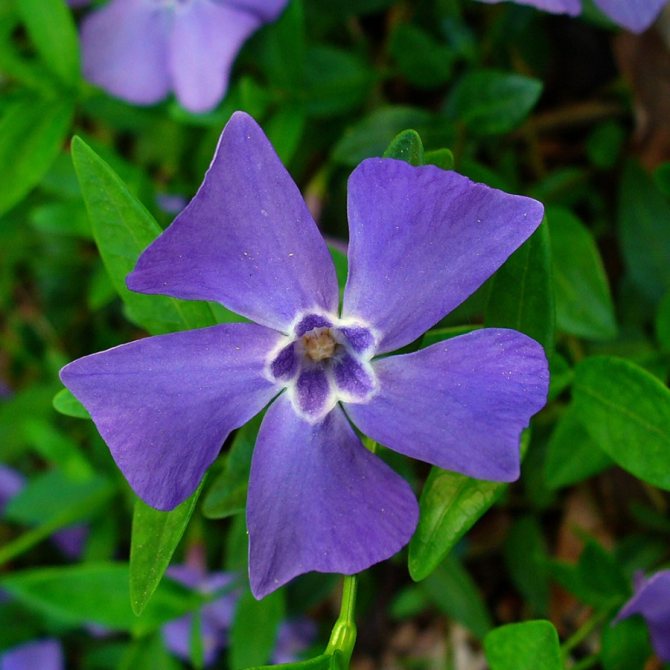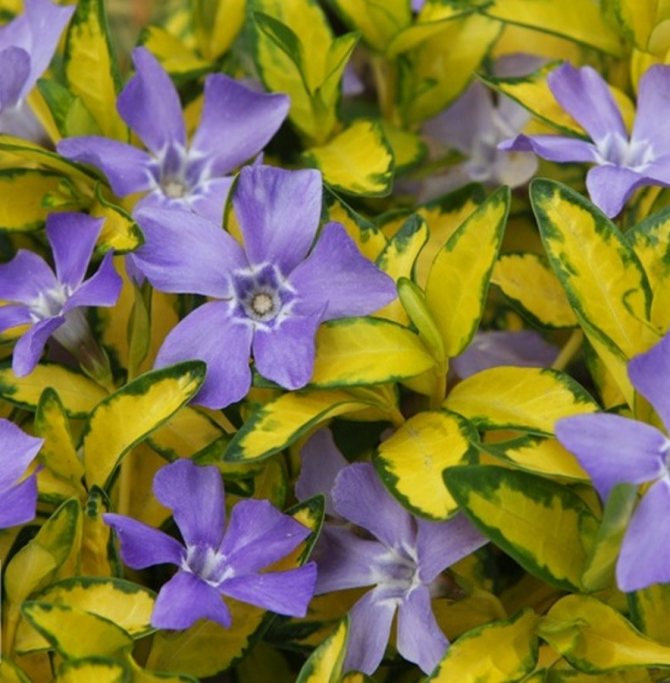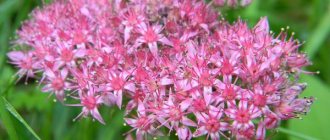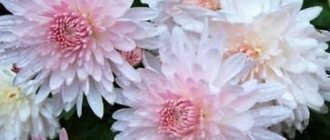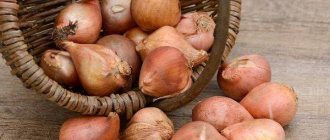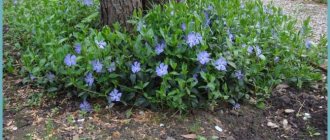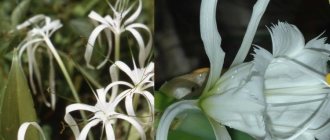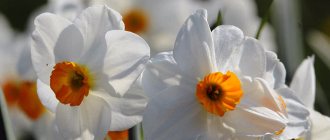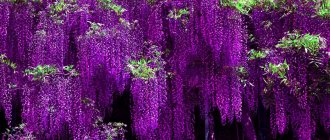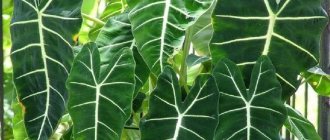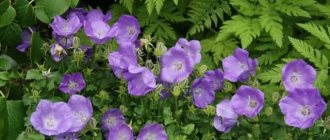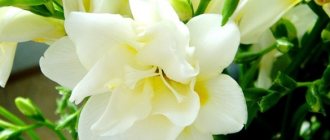Periwinkle: varieties and varieties
Periwinkle is an evergreen perennial that covers flower beds, ridges, slopes with a bright carpet. Unpretentious to maintain, this flower is equally loved by experienced landscape designers and novice gardeners. The leaves of the plant are as if covered with a waxy coating, dense and shiny. The inflorescence of pale purple, pale blue shades consists of five petals.
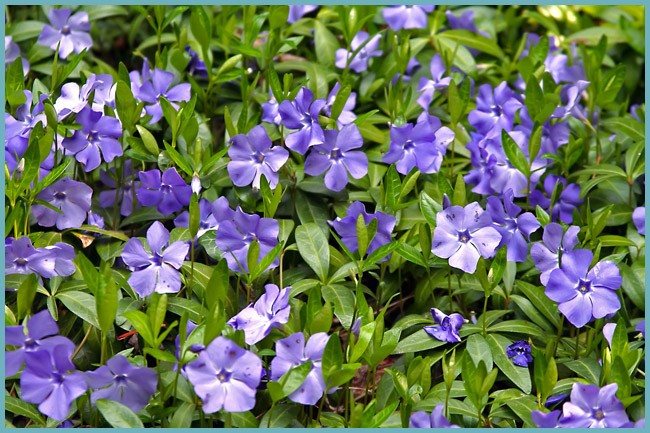
Even periwinkle foliage is a wonderful flower bed decoration.
By planting a periwinkle in a flower garden, you can forever get rid of the need to fight weeds: growing rapidly, the flower completely covers the soil, rooting with shoots and does not give the weeds even the slightest opportunity for growth.
In the wild, there are only a few varieties of periwinkle (small, large, herbaceous, pubescent), but breeders have bred many of its varieties with flowers of various shades.
- Periwinkle large (or Vinca major) has larger leaves and flowers than periwinkle small, under favorable conditions it can bloom twice a year (in May and September), reaches up to 25 cm in height. The Reticulata and Variegata varieties, which are distinguished by the presence of yellow-white streaks on the leaves, are especially popular with designers.
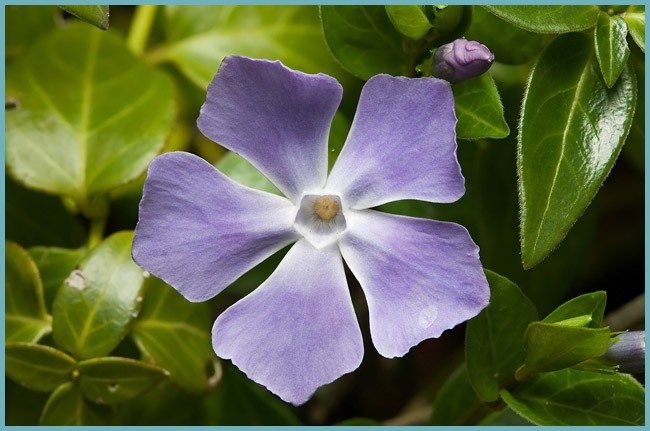

Periwinkle large - Herbaceous periwinkle (or Vinca herbacea) has low frost resistance, it can disappear in the winter. It differs in the shape of the leaves - they are ovoid, small, leathery, of a rich green hue.
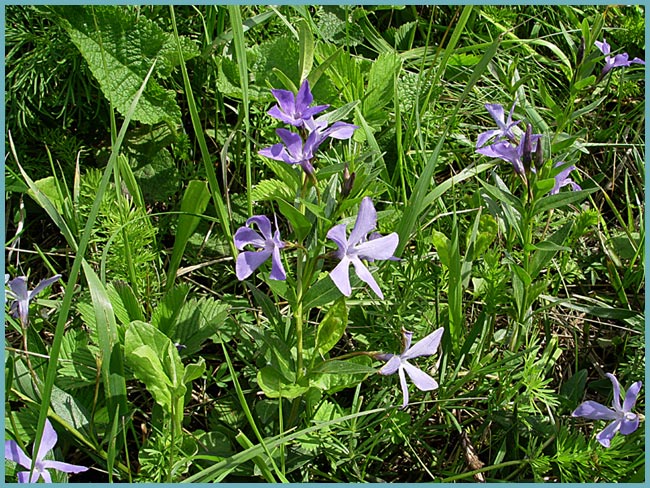

Herbaceous periwinkle - Pubescent periwinkle (Vinca pubescens) also sheds its leaves for the winter, but in general it is frost-resistant, only in extreme cold it needs additional care - shelter. Flowers are small, rising on shoots.
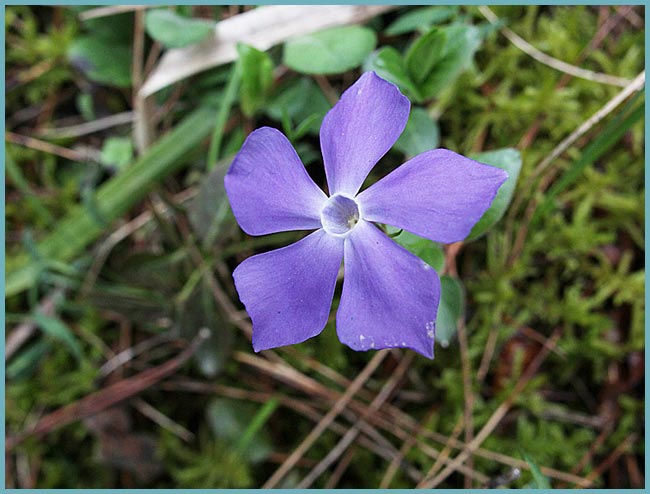

Pubescent periwinkle - Periwinkle (or Vinca minor) is a perennial with leathery elliptical leaves. Frost-resistant to temperatures down to -10 degrees, it can only be damaged in severe frosts. It has creeping stems reaching a length of 100 centimeters or more. Rooting of the plant occurs mainly at the end of summer. Inflorescences are small, blue.
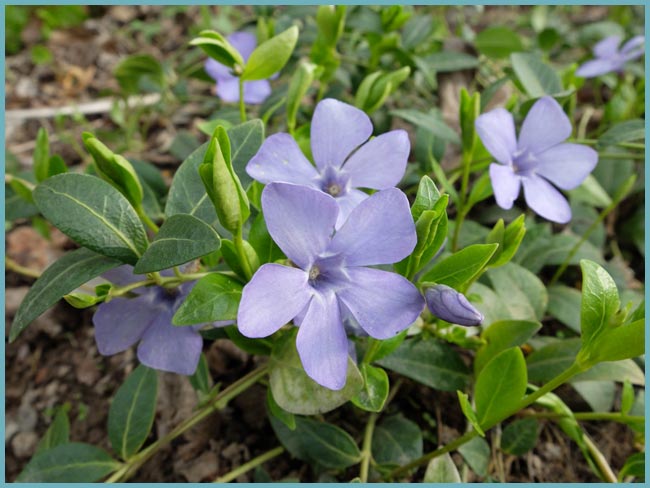

Periwinkle
The following varieties of the lesser periwinkle have been bred:
- Alboplena - periwinkle with double white flowers;
- Argenteo-variegata - leaves are large, bright green with whitish cream interspersed, inflorescences of a pale blue hue;
- Atropurpurea - has a bright purple hue;
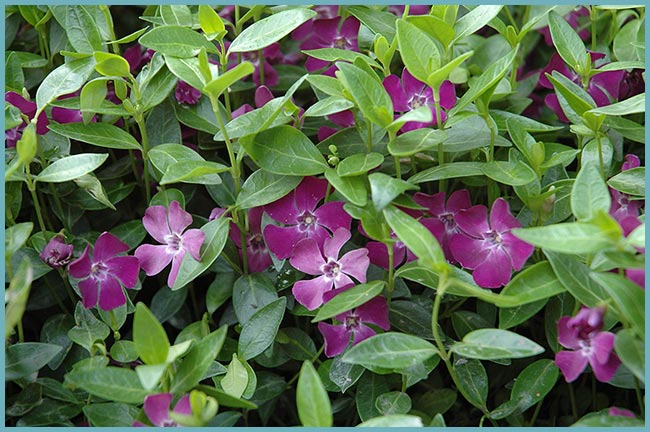

Atropurpurea cultivar
- Emily - just like Alboplena, it has white flowers;
- Bowles' Variety - blooms for a long period, flowers are deep blue.
How to prepare for wintering
Periwinkle is a perennial plant that lives for at least 10 years. The frost-resistant flower is able to withstand short frosts.
Variegated species need winter shelter. The plant is covered with spruce branches, then semicircular metal supports are placed above it and covered with a special non-woven insulation, and on top of it - with plastic wrap. Cold winters without snow are especially dangerous for this flower.
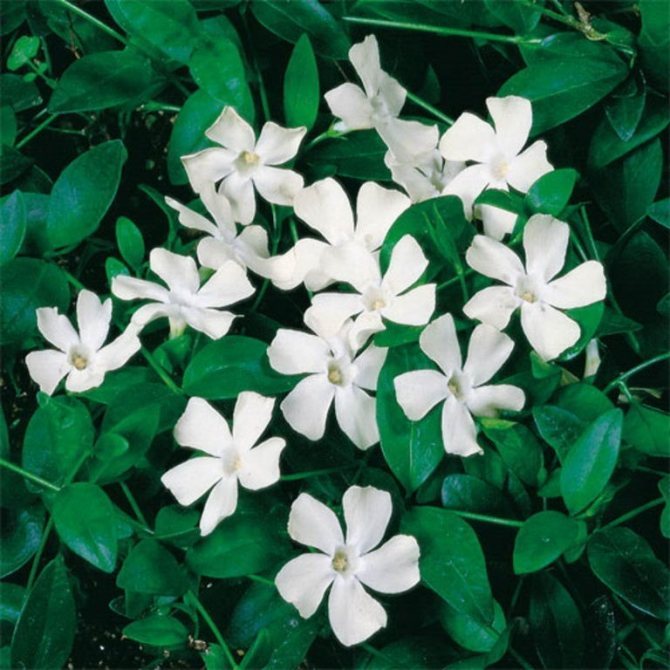

Alba will delight you with large white flowers
Planting a plant
Periwinkle takes root on any soil, it can be planted on the slopes of the site. The perennial will grow rapidly and cover the unsightly terrain with a bright green carpet with blue blotches of flowers. The shrub will grow well in the shade of fruit trees and in the bright sun.
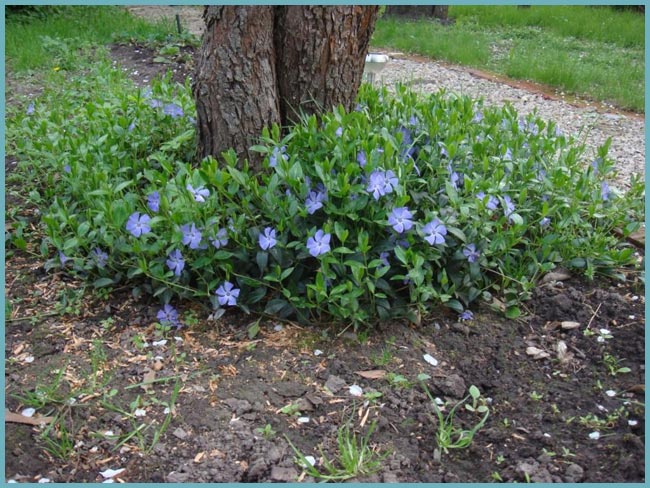

Periwinkle planted in the garden in the shade of trees will look very good
You should adhere to this planting scheme for periwinkle: given that it is a perennial, besides actively growing, it is recommended to plant plants at a distance of at least 30-35 cm from each other.
Growing and care
The periwinkle flower is not picky about the soil. It will take root on any, and after overgrowth, it will hide unsightly areas. The periwinkle will be especially comfortable on drained, loose soil. The plant thrives in the sun and in the shade of trees.
The planted periwinkle quickly spreads and forms a solid, green coating with blue-blue stars.
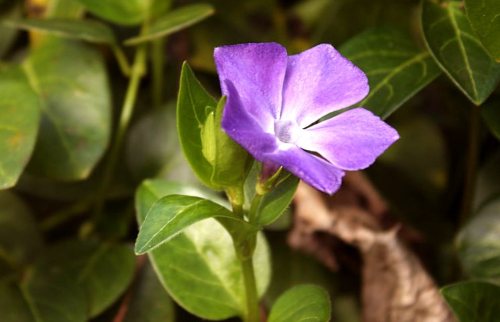

Flowering plant
Bushes of an actively growing flower are planted at a distance of 30-40 cm from each other to provide free space for filling. The arrangement of the outlets in a checkerboard pattern looks beautiful.
Watering is necessary in the spring, when the periwinkle is actively developing and in the first time after planting, so that the plant takes root well. In the future, periwinkle has enough natural moisture that has accumulated in the soil, because it is drought-resistant. On hot days, watering once a week is enough.
In August, the soil under the periwinkle is pierced with a pitchfork 20 cm deep, which ensures soil drainage and oxygen supply to the roots.
In order to prevent spreading over the site, the periwinkle is trimmed after flowering. A haircut also helps to give the bushes a decorative effect.
Plucking the tops of the plant forms a luxurious, soft carpet. The detached stems can be easily rooted and expanded the planting area.
The plant is frost-resistant. However, in extreme cold, experienced flower growers recommend covering young shoots with fallen leaves.
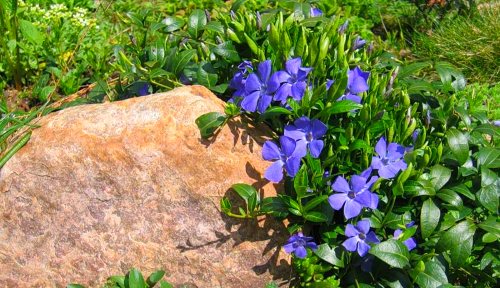

Periwinkle in the garden
Periwinkle grows well in natural conditions, providing itself with organic matter from dying leaves and shoots. He does not really need additional feeding, but the introduction of urea (30 g / m2) and humus with peat compost in the spring during the flowering period and at the end of September has a beneficial effect on growth and development. On old plantings, where the soil is already depleted, dry humus is scattered.
Caring for periwinkle
Caring for periwinkle outdoors is extremely simple - it can be planted on any soil, both in shaded and sunny places. It is necessary to ensure watering only in the early stages of plant growth, in the future it perfectly manages the moisture contained in the soil, it is drought-resistant. Even in the hottest summer, it is recommended to water the periwinkle no more than once every 7-10 days.
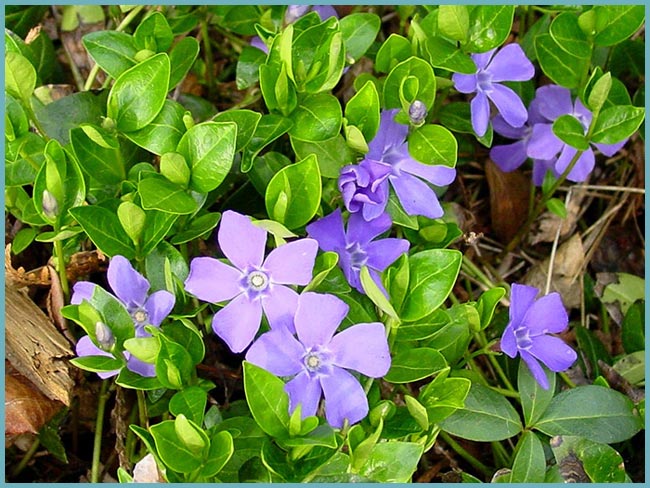

Periwinkle needs almost no care
Despite the fact that this perennial is quite frost-resistant, landscape design experts recommend covering young shoots with foliage for the winter.
Landing in open ground
Most periwinkle varieties should be planted in an area protected from the cold wind, in a completely or partially shaded area. There should not be close to groundwater.
Periwinkle has an important feature - it can be planted at any time of the year. Sowing is done at any time: in early spring, late autumn or summer.
To germinate seedlings, they take a spacious box with earth, make 1 cm deep grooves in the ground and put seeds in them with a step of 1-2 cm. After that, the container is placed in a dark area and covered with polyethylene.
Young plants are planted in separate grooves, the interval between which should be 35 cm.
The roots are straightened and sprinkled with loosened soil, the soil is slightly pressed down. A freshly planted plant is watered with a moderate amount of water.
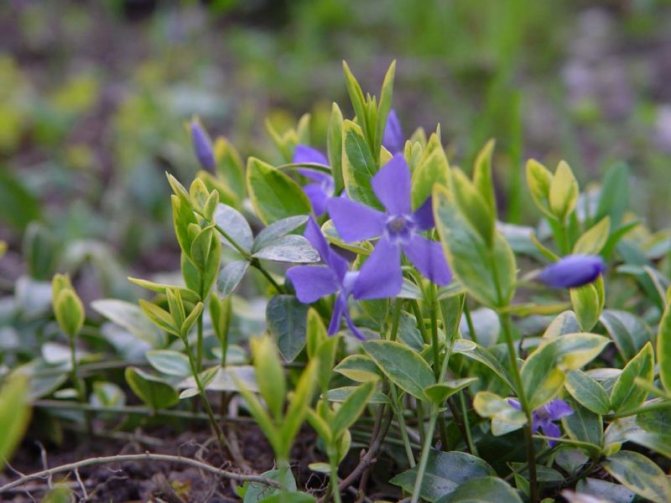

Periwinkle in the open field
Reproduction of periwinkle
Periwinkle, like other perennials, can be propagated in several ways:
- seeds;
- dividing the bush;
- cuttings;
- taps.
The most simple is the planting of periwinkle using dividing the bush... The separated piece of plant quickly takes root in a new place and grows. Experts recommend planting periwinkle in spring or early autumn. It is possible in the summer, but in this case it is necessary to moisten the soil under the plant and at the new planting site.
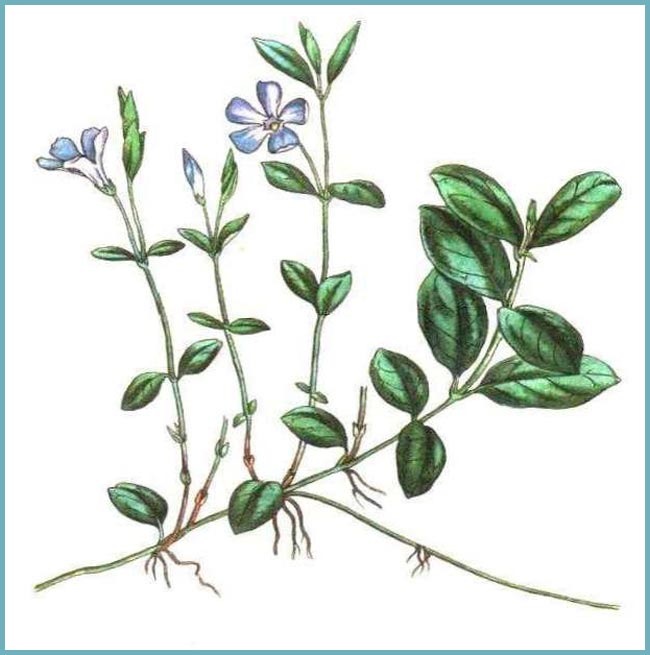

Pattern: periwinkle bush
Periwinkle reproduces well and cuttings... It is necessary to cut the young shoots and bury them using the seating scheme as with propagation by bushes, leaving only a couple of leaves on the surface. In the future, the culture will grow and cover the entire area allotted to it with a green carpet.
For getting diversion you should dig in the shoot of the plant, and after rooting, separate it from the mother bush and transplant it to a permanent place of growth.
Seeds perennials are sown in the spring in boxes to a depth of no more than 2 cm. They are covered for a week with a dense cloth or a dark film that does not allow light to pass through. Seedlings should be grown from seeds indoors or in heated greenhouses, since the comfortable temperature for germination is above +23 degrees. After the emergence of seedlings, boxes with seedlings are exposed to the light, while the temperature can be below +20 degrees. Seedlings dive after the appearance of the first 4 true leaves at a plant height of about 9 cm.
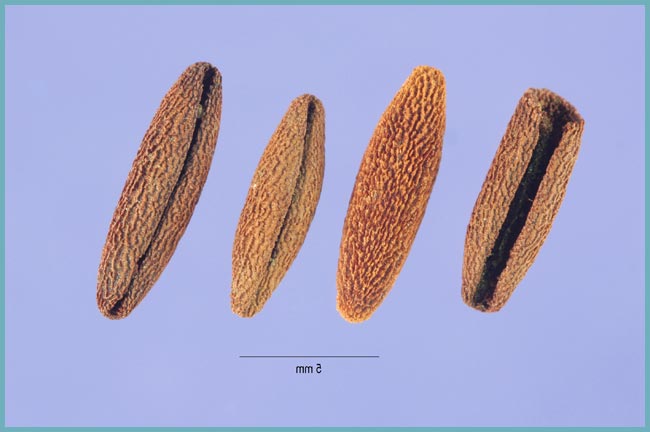

Periwinkle seeds
Experienced gardeners recommend breeding periwinkle in spring, then before winter the plant has more chances to take root, get stronger and survive the winter safely.
Why does not it bloom
The most likely reason why there is no flowering is excessive darkening. If you plant periwinkle under trees, then as much light passes through the crown as the plant needs. But in dark spruce forests, flowers do not appear on the plant.
Rotting roots due to the fact that the soil is not loose, not saturated with air, but also highly filled with moisture, which stagnates, leads to death. Such conditions contribute to susceptibility to various types of diseases, which negatively affects the entire plant, especially the ability to bloom flowers.
Also find out why jasmine does not bloom and grows poorly.
Diseases and pests
Periwinkle is a perennial resistant to many diseases. However, it can be affected by aphids, scabbard, fungal diseases (for example, powdery mildew). To destroy aphids and scale insects, it is recommended to irrigate the plants with soapy water. For the prevention of powdery mildew, proper watering of the shrub should be ensured - it does not tolerate waterlogging, does not grow on swampy soils.
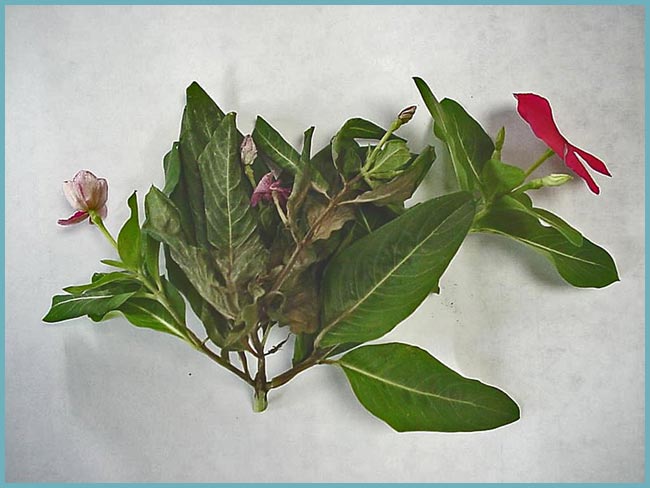

A periwinkle bush affected by a fungal disease
How to keep periwinkle in winter
The species large and pink need special covering. The rest tolerate cold and frost well. Young plants can be protected so that the shoots do not freeze. In order to support the perennial in winter, the bushes of the first year are covered with straw, spruce branches or fallen leaves.
It is important not to remove shelters too early because spring weather is very changeable. It is recommended to mulch young seedlings with rotten organic matter before the onset of winter.
Did you know? If the lovers break the leaf in half and eat each of their share, their connection will not end - the halves of the leaf connect the hearts.
Periwinkle in combination with other plants
Growing up, the periwinkle completely covers the territory allotted to it with a green carpet. This perennial is ideal in garden landscaping, it grows well between trees and shrubs. Grows well in combination with:
- lungwort;
- spills;
- primrose;
- hyacinths, other bulbous plants;
- forget-me-nots.
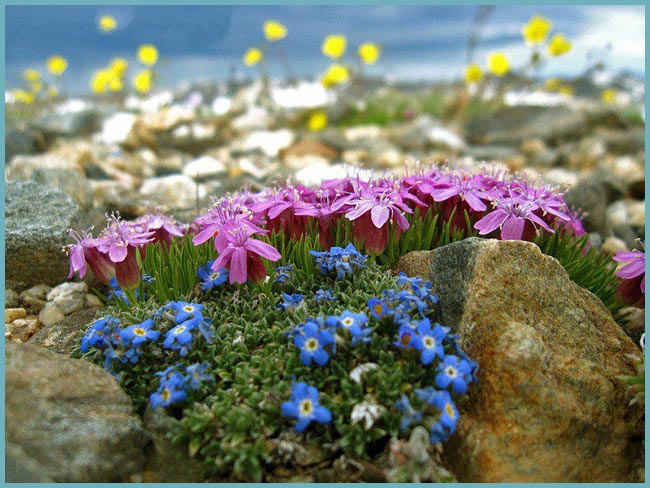

Periwinkle combined with cloves
The decoration of the site will be the planting of a variety of ferns on a periwinkle pillow.
Tip: control the growth of periwinkle, otherwise it can turn into a weed and drown out crops.
Periwinkle in landscape design
Periwinkle is often used in open field design to decorate wide borders, bordering ridges, this plant looks great in mixborders. In any photo, periwinkle sets off and emphasizes the beauty of the cultures that grow with it.
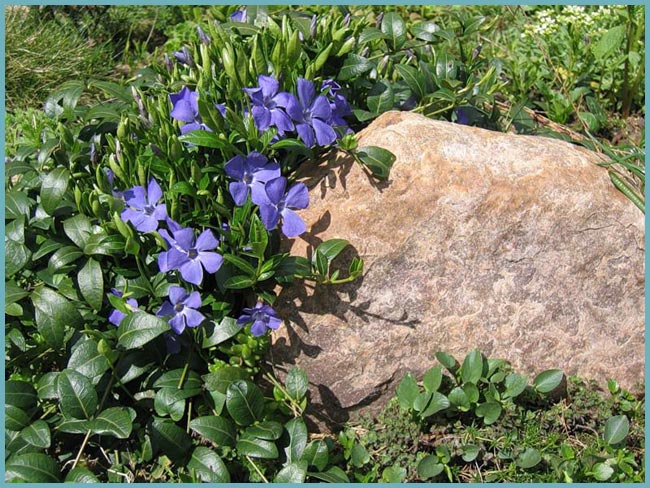

Periwinkle in landscape design
Plant a periwinkle on the site and get an excellent opportunity to enjoy the view of a living green carpet all year round.
Top dressing
In order for the perennial to develop and bloom better, it is fed with complex mineral fertilizers, alternating with the introduction of organic matter - humus, compost or rotted manure.
You can feed periwinkle 2-3 times during the spring-summer season. Fertilization can be applied in the spring in April and May, then in the middle of summer.
In its pure form, mullein or chicken droppings are not used, since such organics can burn the delicate root system of Periwinkle, as a result, the flower will hurt or die. Infusions should be made from these organic fertilizers.

